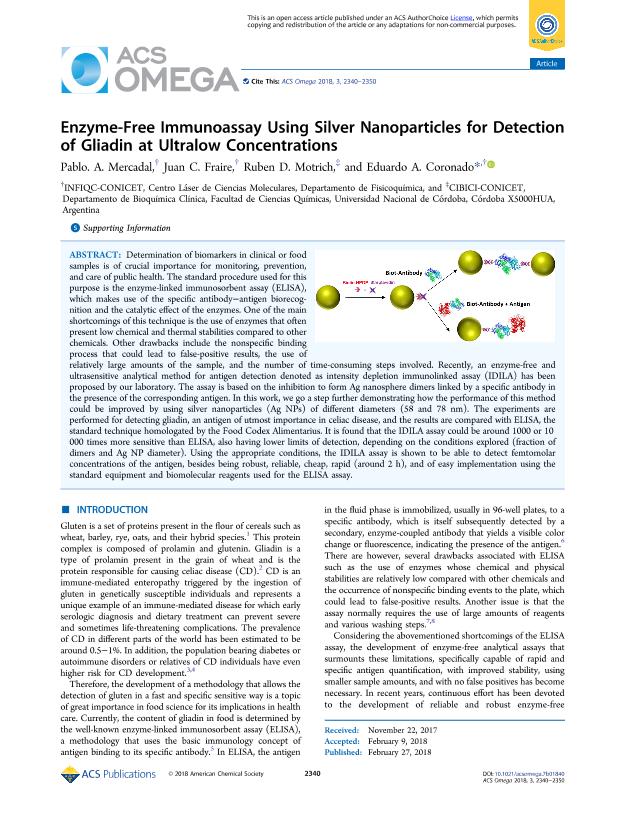Mostrar el registro sencillo del ítem
dc.contributor.author
Mercadal, Pablo Agustin

dc.contributor.author
Fraire, Juan Carlos

dc.contributor.author
Motrich, Ruben Dario

dc.contributor.author
Coronado, Eduardo A.

dc.date.available
2019-10-22T17:27:27Z
dc.date.issued
2018-02
dc.identifier.citation
Mercadal, Pablo Agustin; Fraire, Juan Carlos; Motrich, Ruben Dario; Coronado, Eduardo A.; Enzyme-Free Immunoassay Using Silver Nanoparticles for Detection of Gliadin at Ultralow Concentrations; American Chemical Society; ACS Omega; 3; 2; 2-2018; 2340-2350
dc.identifier.uri
http://hdl.handle.net/11336/86907
dc.description.abstract
Determination of biomarkers in clinical or food samples is of crucial importance for monitoring, prevention, and care of public health. The standard procedure used for this purpose is the enzyme-linked immunosorbent assay (ELISA), which makes use of the specific antibody-antigen biorecognition and the catalytic effect of the enzymes. One of the main shortcomings of this technique is the use of enzymes that often present low chemical and thermal stabilities compared to other chemicals. Other drawbacks include the nonspecific binding process that could lead to false-positive results, the use of relatively large amounts of the sample, and the number of time-consuming steps involved. Recently, an enzyme-free and ultrasensitive analytical method for antigen detection denoted as intensity depletion immunolinked assay (IDILA) has been proposed by our laboratory. The assay is based on the inhibition to form Ag nanosphere dimers linked by a specific antibody in the presence of the corresponding antigen. In this work, we go a step further demonstrating how the performance of this method could be improved by using silver nanoparticles (Ag NPs) of different diameters (58 and 78 nm). The experiments are performed for detecting gliadin, an antigen of utmost importance in celiac disease, and the results are compared with ELISA, the standard technique homologated by the Food Codex Alimentarius. It is found that the IDILA assay could be around 1000 or 10 000 times more sensitive than ELISA, also having lower limits of detection, depending on the conditions explored (fraction of dimers and Ag NP diameter). Using the appropriate conditions, the IDILA assay is shown to be able to detect femtomolar concentrations of the antigen, besides being robust, reliable, cheap, rapid (around 2 h), and of easy implementation using the standard equipment and biomolecular reagents used for the ELISA assay.
dc.format
application/pdf
dc.language.iso
eng
dc.publisher
American Chemical Society
dc.rights
info:eu-repo/semantics/openAccess
dc.rights.uri
https://creativecommons.org/licenses/by-nc-sa/2.5/ar/
dc.subject
PLASMONIC NANOPARTICLES
dc.subject
BIOCONJUGATION
dc.subject
SENSING
dc.subject
IMMUNOASSAY
dc.subject.classification
Nano-materiales

dc.subject.classification
Nanotecnología

dc.subject.classification
INGENIERÍAS Y TECNOLOGÍAS

dc.title
Enzyme-Free Immunoassay Using Silver Nanoparticles for Detection of Gliadin at Ultralow Concentrations
dc.type
info:eu-repo/semantics/article
dc.type
info:ar-repo/semantics/artículo
dc.type
info:eu-repo/semantics/publishedVersion
dc.date.updated
2019-09-30T18:25:27Z
dc.identifier.eissn
2470-1343
dc.journal.volume
3
dc.journal.number
2
dc.journal.pagination
2340-2350
dc.journal.pais
Estados Unidos

dc.journal.ciudad
Washington
dc.description.fil
Fil: Mercadal, Pablo Agustin. Universidad Nacional de Córdoba. Facultad de Ciencias Químicas. Departamento de Fisicoquímica; Argentina. Consejo Nacional de Investigaciones Científicas y Técnicas. Centro Científico Tecnológico Conicet - Córdoba. Instituto de Investigaciones en Físico-química de Córdoba. Universidad Nacional de Córdoba. Facultad de Ciencias Químicas. Instituto de Investigaciones en Físico-química de Córdoba; Argentina
dc.description.fil
Fil: Fraire, Juan Carlos. Universidad Nacional de Córdoba. Facultad de Ciencias Químicas. Departamento de Fisicoquímica; Argentina. Consejo Nacional de Investigaciones Científicas y Técnicas. Centro Científico Tecnológico Conicet - Córdoba. Instituto de Investigaciones en Físico-química de Córdoba. Universidad Nacional de Córdoba. Facultad de Ciencias Químicas. Instituto de Investigaciones en Físico-química de Córdoba; Argentina
dc.description.fil
Fil: Motrich, Ruben Dario. Consejo Nacional de Investigaciones Científicas y Técnicas. Centro Científico Tecnológico Córdoba. Centro de Investigaciones en Bioquímica Clínica e Inmunología; Argentina
dc.description.fil
Fil: Coronado, Eduardo A.. Universidad Nacional de Córdoba. Facultad de Ciencias Químicas. Departamento de Fisicoquímica; Argentina. Consejo Nacional de Investigaciones Científicas y Técnicas. Centro Científico Tecnológico Conicet - Córdoba. Instituto de Investigaciones en Físico-química de Córdoba. Universidad Nacional de Córdoba. Facultad de Ciencias Químicas. Instituto de Investigaciones en Físico-química de Córdoba; Argentina
dc.journal.title
ACS Omega
dc.relation.alternativeid
info:eu-repo/semantics/altIdentifier/url/http://pubs.acs.org/doi/10.1021/acsomega.7b01840
dc.relation.alternativeid
info:eu-repo/semantics/altIdentifier/doi/http://dx.doi.org/10.1021/acsomega.7b01840
Archivos asociados
